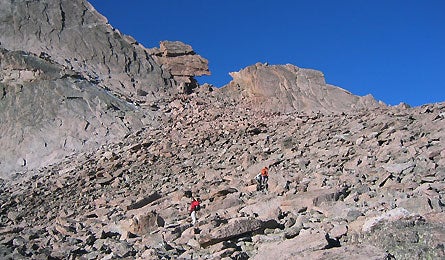Prof. Hike: 5 Gear Tune-Ups for the New Year

'Motivate yourself to tune-up gear (and body) with a big trip. (JS)'
Now is the time to start planning for May, June, and July. Not because it’s so frosty outside that your dog flashes you a “Are you freakin’ kidding me?” look when you grab his leash. But because winter’s frozen middle is the perfect time to prep your gear for the next hiking season. Wait until spring and you run the risk of discovering your stove is kaput or your sleeping pad is leaking the day before your first hike. So instead of hibernating, get outside to enjoy the winter and then do these five things to get ready for spring.
(1) Buy Summer Gear
Unlike fruits and vegetables, outdoor gear and clothing is cheaper during the off-season. Need more wicking T-shirts and nylon shorts? Shop in January. Are your baselayers threadbare? Get covered in July. Good deals can be found year-round, but the best bargains for warm-weather gear appear right now. Not only is Christmas in the bag, but retailers need to sell last year’s stuff to make room for this year’s products. Online shoppers should start at the outlet basements of REI and EMS, and then peruse the bargains at Campmor. And don’t forget your local outdoor specialty store and networks like Craigslist. Warning: Deep discounts can distort your brain. Even if that micro-wool pullover is 60 percent off, ask yourself if you really need it.
(2) Manage Your Perishables
Last month I ate a dehydrated meal I purchased during the Bush Administration. The first Bush Administration. Salty but good. Most gear doesn’t expire except for two categories: dehydrated food and stove fuel. Storing several freeze-dried meal packets in a cupboard is a smart way to enable last-minute backpacking trips. But take note of the expiration date and the condition of the bag. I’ve eaten rehydrated meals up to five years after their listed expiration date and suffered no ill consequences (no more than with my own cooking). Still, I now eat the oldest meals first, and pitch the ones that look too crumpled. Opinions vary among thrifty hikers, but the consensus is that you can consume dehydrated meals up to several years after the dates listed on the package. To maximize the shelf-life of freeze-dried food, store it in a cool, dark, temperature-stable place, and ensure the foil pouch is intact before using.
Stove fuel doesn’t expire, per se, but it does get used up. Like me, you’ve probably got several half-empty isobutane canisters in your closet. How much gas is left in them? I have no idea. Or at least I didn’t until I hauled them to the post office and weighed each canister on a digital scale. I recorded each canister’s weight in ounces and brought them home. Comparing the weights of full canisters to identical, partially used ones gave me a rough indication of how much fuel was left. For more precise weight comparisons, check out the nifty chart at zenstoves.net.
To dispose of spent canisters, drain them by turning on your stove (but not lighting it) in a well-ventilated place (i.e., not next to your furnace). Once it’s drained, punch a hole in the side with a bottle-opener to indicate it’s no longer pressurized. This makes them safe for recycling or the trash (check local recycling rules first). JetBoil’s CrunchIt tool does it all—draining the canister and puncturing the sidewall. Prof. Hike, however, has fond memories of detonating expended canisters with his .22 rifle. You always knew when you hit the target.
(3) Keep it Clean
Is that mud on your boots? Dirt-caked shoes and boots not only look bad, but the organic compounds and acids in grime corrode leather and fabrics, especially during the long winter months when they sit in your closet. If you haven’t already, clean your footwear by washing them with warm water and mild soap. Remove stubborn gunk with a soft-bristled vegetable brush. Let them air dry completely before storing in a cool, dry place away from radiators, vents, or base-board heaters. And while you’re at it, apply a new DWR (durable-water repellant) coating that is specific for the boot’s fabric or hide. Why do this in January? Because it takes 24 hours for these waterproof coatings to dry, so you can’t do it the night before you leave for a trip. For more footwear tips, check out Backpacker’s Ultimate Fix-It Guide.
(4) Fix Failing Gear
Remember that sputtering stove or flickering headlamp you used last summer? Now, and I mean right now, is when you should fix or replace those items. A few years ago a Naval Academy graduate and friend of mine chastised me for wearing a watch with a dead battery. “Why didn’t you fix it right away?” he asked. At the time I shrugged, but now I realize his point. I was a newbie magazine writer. He flew attack helicopters bristling with rocket pods. If my watch stopped, I might arrive late to an interview. If his equipment broke, it could cost him his life. To maintain essential gear like water filters, stoves, and headlamps, you should adopt my friend’s Marine Corps mentality toward safety. Instead of tinkering with a clogged stove three days into a backpacking trip, clean it right now on your kitchen table when the consequences are much less dire.
(5) Get (Back) in Shape
Yes, we all want Jon Dorn’s legs. His ample quads propel him from Boulder’s bike paths to the sandy deserts of Arabia. Achieving Dorn-like fitness, however, is within your reach. The first step is setting a goal. Besides a school reunion, nothing will encourage you to get in shape like scheduling a big trip. Knowing I would climb several Colorado peaks last summer forced me to start running again. And even though my home elevation was 10,000 feet lower than the trailhead, a month of intensive training got me to the summits. When winter’s ice, snow, and cold keep you from running or walking, embrace the cold season’s cardio alternatives: snowshoeing and cross-country skiing. Even ice-skating provides a great workout. I’m also a fan of everyday fitness activities like these:
- >Take your dog for a walk instead of to the dog park.
- >Run errands on foot instead of driving.
- >Hit the gym during your lunch break instead of after work (when it’s much more tempting to skip).
- >Opt for the stairs over escalators and elevators—even at the airport.
- >Deliberately park far away from a shopping center or grocery store; or exit the subway or bus a stop early and walk.
- >Bike to work.
- >Visit a colleague’s office instead sending an email or making a call.
Do you have your own gear-overhaul tips? Share them in the comments section, or send an email to profhike@backpacker.com.
In two weeks I’ll explain why everyone should try winter camping and hiking.
—Jason Stevenson
Jason Stevenson is the author of The Complete Idiot’s Guide to Backpacking and Hiking
